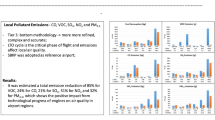Abstract
In this chapter the lower take off cycle and total flight fuel consumptions and emissions of B737-400 commercial aircraft for selected routes are being calculated and evaluated for specified flight parameters. For case studies Eskisehir–Istanbul, Trabzon–Istanbul, and Ankara–London flights are selected as short-, medium-, and long-range flights with having 350, 980, and 3,270 km flight distances. The primary emissions released to environment are CO2, CH4, N2O, NOx, CO, and SO2. During Ankara–London flight with aircraft maximum takeoff weight operation (68,040 kg), B737-400 consumes 12,660 kg fuel and as a result 40,000 kg of CO2, 1.296 kg of CH4, 1.62 kg of N2O, 116.7 kg of NOx, 211.5 kg of CO, and 12.66 kg of SO2 are emitted into environment.
Access this chapter
Tax calculation will be finalised at checkout
Purchases are for personal use only
Similar content being viewed by others
Abbreviations
- IPCC:
-
Aviation and the global atmosphere
- Kt:
-
Knot, nautical mile/h
- LTO:
-
Lower takeoff
- MTOW:
-
Maximum takeoff weight, kg
- LW:
-
Landing weight, kg
- PL:
-
Payload, kg
- TOW:
-
Takeoff weight, kg
References
Kristin R, Niels K, Steve S, and Karen T (2000) Aircraft emissions. Energy Sector: 93–102
IPCC Aviation and the Global Atmosphere (2006) IPCC Guidelines for National Greenhouse Gas Inventories. Website http://www.ipcc-nggip.iges.or.jp/public/2006gl/
BOEING 737-400 (1988) Operation Manual Enroute Climb 280/.74 ISA, Integrated Range Mach 0.78 Cruise and 0.74 M/250 KIAS Descent performances Tables
Aydin H (2012) Development of exergetic sustainability indicators of commercial aircraft. Ph.D. Thesis, Natural and Applied Science, Anadolu University, Eskisehir, Turkey
IPCC (1999) Aviation and the Global Atmosphere. Cambridge University Press, Cambridge
Bruno M, Kenneth M, John-Paul C (2008) Constraints in aviation infrastructure and surface aircraft emissions. Massachusetts Institute of Technology, Cambridge, MA, Retrieved 2008-01-02
EU (2006) Climate change: commission proposes bringing air transport into EU, IP/06/1862
US GAO (2009) Aviation and climate change: aircraft emissions expected to grow, but technological and operational improvements and government policies can help control emissions, GAO-09-554
Author information
Authors and Affiliations
Editor information
Editors and Affiliations
Rights and permissions
Copyright information
© 2013 Springer Science+Business Media New York
About this chapter
Cite this chapter
Aydın, H., Turan, O., Karakoc, T.H., Midilli, A. (2013). Emission Analysis of a Commercial Aircraft for Different Ranges. In: Dincer, I., Colpan, C., Kadioglu, F. (eds) Causes, Impacts and Solutions to Global Warming. Springer, New York, NY. https://doi.org/10.1007/978-1-4614-7588-0_50
Download citation
DOI: https://doi.org/10.1007/978-1-4614-7588-0_50
Published:
Publisher Name: Springer, New York, NY
Print ISBN: 978-1-4614-7587-3
Online ISBN: 978-1-4614-7588-0
eBook Packages: EnergyEnergy (R0)




